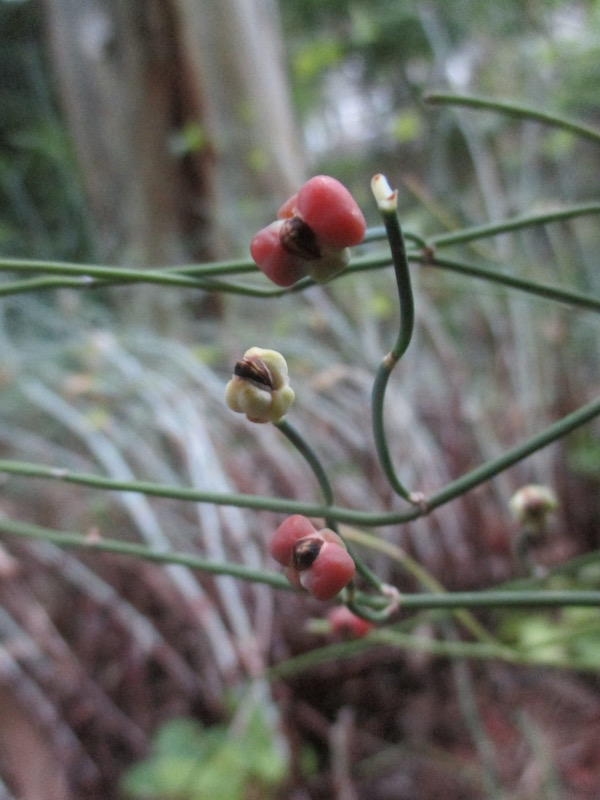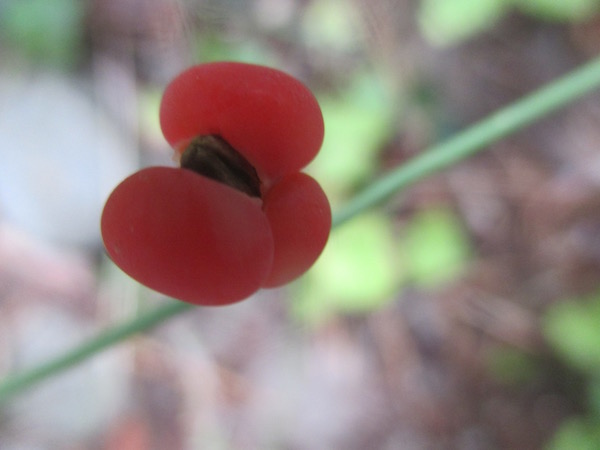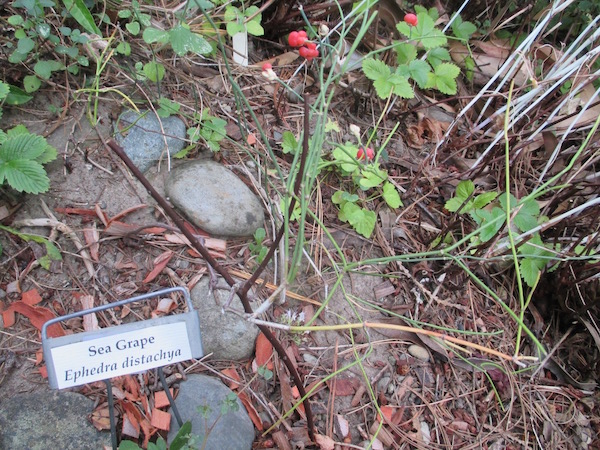| In 2016, an Ephedra plant that I transplanted to my Seattle garden in either 1991 or 1992, has fruited for its first time. Thus, this article about it. |
| Genus Ephedra consists of perhaps 60 shrubby species from arid and semiarid regions in both the Old World (mostly) and New World (23 spp.). It is the only genus in its family; its nearest relatives are the tropical Gnetum and South African Welwitschia genera. |
| All these three genera are gymnosperms, of ancient derivation in the early Cretaceous period. Hence they are more near kin of pine trees than flowering plants (angiosperms). |
| Most Ephedra species have male and female reproductive parts on different individual plants. Most are wind-pollinated. Their leaves are tiny and ephemeral usually, so photosynthesis is done by their stems, that are green or blue-green or gray-green. Most (over 42 species) produce fleshy fruits that botanists call cones; these are usually red but can be yellow or white. They are adapted to dispersal by birds, lizards and the like. A dozen or more species make dry fruits that are membraneous with large seeds, or papery rather than fleshy, adapted for dispersal by rodents or wind. |
| Most Ephedra grow in full sun, on well-drained soil, often alkaline rather than acidic. They tend to tolerate extremes of heat, dryness, wind, and cold. That is, most are what people call tough. |
| Human use of Ephedra is mainly in three categories: food, medicine and ornamental. At least 25 species have been reported eaten by humans. Either the fruit or its seed are eaten, or less often the twigs are brewed into a non-medicinal tea such as Mormon Tea. |
| Medicinal use of Ephedra is better known currently to most people, due to the nearly cult-like attention lavished on Ephedra sinica Stapf (Ma Huang) and allied east Asian species Ephedra equisetina and Ephedra intermedia. In China, it has been used medicinally for thousands of years, for example to treat bronchitis and asthma. In the West, in 1925, medical researchers learned that the alkaloid ephedrine was helpful to treat shock. Ephedrine resembles adrenaline in action, and is ideal to treat shock. But it is overused by unwary people, and deaths have resulted. |
| The garden ornamental role of Ephedra is minor. Some species, well grown, are attractive even when bare; but the specimens laden with ripe red fruit are esteemed most highly. The superior 2007 Sunset Western Garden Book includes 4 species; the inferior 2012 edition omits the genus entirely. You are most likely to see Ephedra plants at botanic gardens. In the U.S.A., the best source I know to buy plants or seeds is Sacred Succulents, in California. About a dozen species are retailed by that company. |
| Glasshouse Works nursery of Ohio offers Ephedra Regeliana Florin as Vining Ephedra and says it can be grown as a houseplant. None of my houseplant books list the genus. I expect that anyone who can grow potted desert cacti and sun-needing succulents indoors, can grow an Ephedra as well. Maximum light is needed. |
| Despite the fact that no Ephedra are native in the British Isles or in Seattle, some can grow and fruit in such relatively cloudy and moist places. In Seattle, at the University of Washington Medicinal Herb Garden, Ephedra distachya grew for decades. When the plants there were going to be bulldozed in a project of rebuilding the Chemistry Building in 1992, I salvaged some. At this date, I do not recall if I dug intentionally both male and female pieces of roots. But the plants have been in the same spot in my garden for some 25 years . . . and were fruitless until right now. It appears I have a fruitless twig, and one bearing about 5 fruits. I shall eat the red parts (they recall yew berries), save their seeds and sow them. It is no longer at the Medicinal Herb Garden but I can give my seedlings (if they grow) to that garden. |
Ephedra distachya grows from SW Europe to C Asia. It is wind pollinated and functionally dioecious. English names include Sea Grape and Shrubby Horsetail. It was cultivated in England by the 16th century. Some U.S.A. nurseries sold it in the 1900s.
Back |

Ephedra distachya fruit unripe; photo by ALJ
|

Ephedra distachya ripe fruit in Seattle; photo by ALJ
|

Ephedra distachya ripe fruit in Seattle; photo by ALJ
|

Ephedra distachya in a Seattle garden; photo by ALJ
|

Ephedra distachya harvested fruit; photo by ALJ
|

Ephedra distachya seeds; photo by ALJ
|

